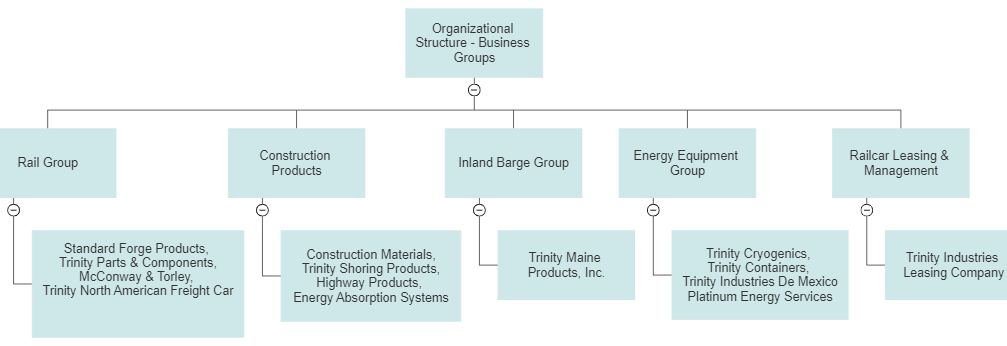Introduction
Trinity Industries is a U.S. company with a long history of operating. It was created in 1958 after two propane tank companies, which experienced financial difficulties, merged into one firm (Shultze, 2011). With the great efforts of Ray Wallace, Trinity Industries’ first chief executive officer, the company moved from manufacturing butane tanks to a diversified corporate group company that operates in the industrial, construction, energy, and transportation sectors (Shultze, 2011). The list of manufactured products in Trinity Industries is endless, with propane tanks, highway guardrails, and wind towers being only some of them (Shultze, 2011). The major slice of clients are large owners of railroads and trains.
After the outbreak of the COVID-19 pandemic, the company strikingly reduced the number of employees, which shows how the size of the company has recently reduced. For example, in 2007, Trinity Industries had 14400 employees (Shultze, 2011), while in 2021, it had only 2000 people (Macrotrends, 2021). Thus, the rapid size reduction is the main current feature of this company. As for competitors in transportation manufacturing, three of them are Greenbrier Companies Inc, FreightCar America, and Arcosa. Comparing their market cap with Trinity Industries, the information from Yahoo Finance shows that all these companies have a lower market cap than Trinity International.
Organizational Structure
The organizational formation in Trinity Industries can be identified by using the company’s official websites, where all the major staff is presented. Before that, there was a sense to introduce the concept of organizational structure. The literature defines it as “a system that determines how tasks are formally structured and coordinated within a group that is intentionally organized to accomplish a common goal” (Nene & Pillay, 2019, p. 11). The analysis of the site showed that this company has corporational business structure.
A chart is a great option to clarify the organizational structure in Trinity Industries (Figure 1). The governance policy here is constructed upon the rule of delegation of roles among different chief executives. To construct the chart further, there is a need for more information which is not available through the website. For example, it is unclear in what way chief officers are connected with operating activities that are certainly located below them in hierarchy. It is evident that executive officers direct and guide operating activities but the connections between real organizational roles is hard to trace. In such a logic, different segments of companies operating as railroad construction, railcars leasing and rail transportation are accountable to executive officers and their team, while executives have an equal voice in the internal discussion.

In continuation of the previous organizational structure chart, Figure 2 outlines the internal structure of Trinity Industries linked with the various business segments and tasks. The corporation is divided into five large business groups, each of which has from one to four units or subsidiary companies operating in the U.S. and abroad. Nevertheless, the corporation does not offer enough information about each unit’s internal managerial hierarchies.

Yearly Performance
In order to understand the market more, one should compare the revenues for previous years of competing companies. During the subsequent company research endeavors, this information will facilitate the identification of the leader in the market, as well as the outsider in the competition. In the post-COVID-19 era, many companies in the railroad industry experienced a rapid decline in revenues because of many cancellations and restrictions. In the table below, the revenues of Trinity Industries will be compared with the firms mentioned in the overview segment (Table 1). The comparison shows that other companies also experienced a recession during the COVID-19 pandemic, so the major concern for Trinity Industries should be a careful look at the recovery of others from the crisis. Trinity’s operating activities include funds from operations, depreciation, depletion, amortization, sales of railcars, and so on (“Trinity Industries Inc.,” 2022).
Table 1: The comparison of revenues in Trinity Industries’ competitors
Management and Culture
Finally, the last segment of this report will be devoted to the overall discussion on how the internal culture is organized. The major commonality is that Trinity Industries has a quite new set of chief officers who started their work recently. For example, two of the most important employees in the system, the CEO and CFO, started to work there in 2020 (Bloomberg, n.d.). In recent years after the crisis, Trinity Industries continued to experience downfall, so a new philosophy of solving organizational problems was needed for improvement. The recent crisis stopped the rapid rise of this company which continued for decades over the history before from the company establishment (Schultze, 2011). Thus, the 2020s are considered to be the key decade for the company’s survival.
Conclusion
The management style in this company can be identified as democratic. All the executive officers also have the role of “executive vice president”, which gives them the right to express their own opinion and be heard (Trinity Industries, n.d.a). Particularly, Jean Savage’s management style is described as one based on compassion and understanding one’s subordinates’ perspectives and challenges (Perez, 2021). Trinity Industries (n.d.c) explains its culture as the combination of five crucial values and decision-making priorities, including the promotion of integrity at all organizational levels, fostering innovation, promoting excellence, staying committed to promises and ideals, and welcoming talented employees from diverse backgrounds and social groups.
References
Bloomberg. (n.d.). E Jean Savage. Web.
Macrotrends. (2021). Trinity Industries number of employees 2010-2022. Web.
Nene, S. W., & Pillay, A. S. (2019). An investigation of the impact of organisational structure on organisational performance.Financial Risk and Management Reviews, 5(1), 10-24. Web.
Perez, C. (2021). How former Caterpillar exec Jean Savage is transforming Dallas’ Trinity Industries.D Magazine. Web.
Schultze, U. (2011). The SOX compliance journey at Trinity Industries.Journal of Information Technology Teaching Cases, 1(2), 91-113. Web.
Trinity Industries Inc. (2022). WSJ Markets. Web.
Trinity Industries. (n.d.a). Senior management & directors. Web.
Trinity Industries. (n.d.b). Trinity’s business segments. Web.
Trinity Industries. (n.d.c.). Trinity’s values and culture. Web.